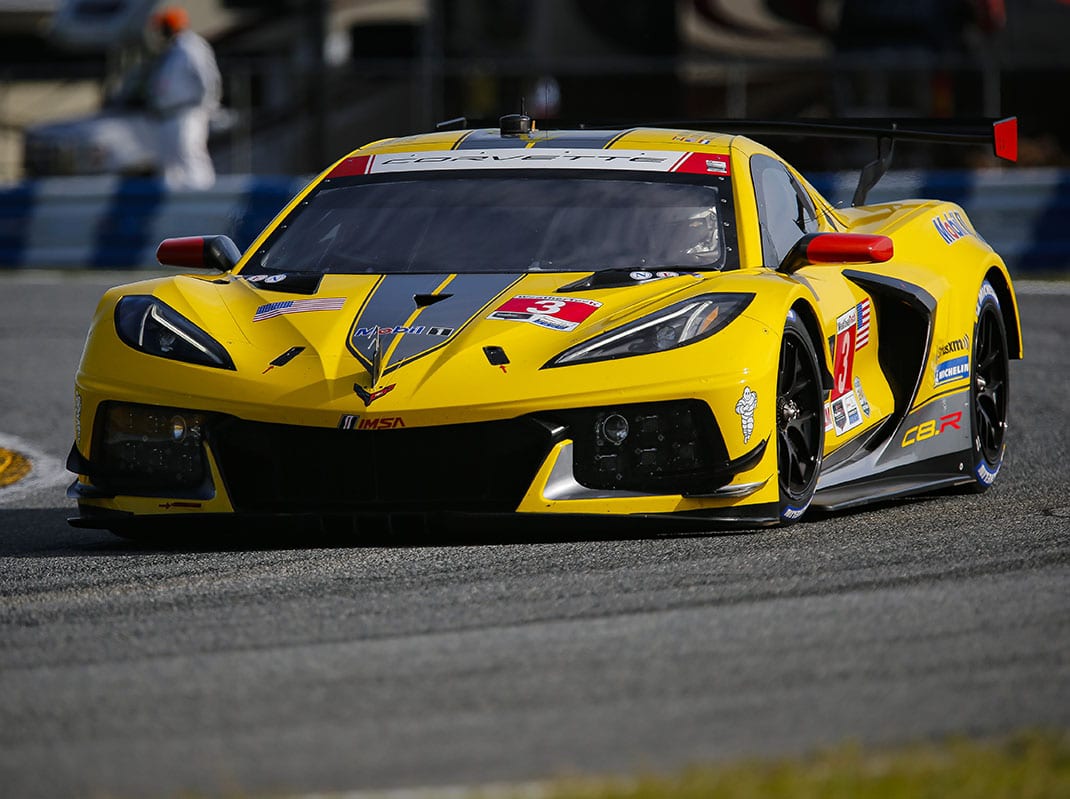Twenty years later, Corvette C8-R enters a new era. Putting all the pieces together has been job one for Pratt and his company.
When asked about testing, Pratt said, “We’ve done enough. We’d like to do more. Testing went pretty good. We’re pleased with the performance.”
But a larger question mark looms — reliability. He recalled the old racing adage: “To finish first, first you must finish.”
There will be a different sounding V-8 engine behind the driver for the first time. Pratt is mum on the details but did say, “The base car is close to what we will have (for horsepower), but when the ZO6 or ZR1 or whatever they call the next performance levels debut, they’ll have more power than what we do. And that’s not a bad thing. Doing endurance racing and having the (air intake) restrictors, it makes the cars way more reliable and the race way more entertaining for everybody.”
But why a mid-engine car now?
Fehan says the front-engine design wasn’t maxed out.
“That would be the common-sense deduction,” he said. “But with the Balance of Performance in place, it doesn’t matter what you bring. If you’re going too fast, they’re going to throttle you back. If you’re not fast enough, they’re going to give you enough to be competitive. There wasn’t a huge amount of pressure from a racing perspective to move to a mid-engine design.
“However, from a road-car perspective, that’s exactly what had taken place.” And that’s because Fehan knows how the racing program drives the sales program.
“Race on Sunday, sell on Monday” is very much alive and well.
In addition, there’s this. “We always think of speed as the ultimate measure,” Fehan noted,” but if you can give a guy a car that’s easier to drive, he can put it in places that he couldn’t normally put it on the track. It makes a huge difference when you’re out there racing. The mid-engine platform is proving that to be true.”
The driver lineup has also changed.

Jan Magnussen is gone and Jordan Taylor has joined the team, recruited from his father’s Cadillac DPi effort. Taylor was involved in early shakedown tests.
“I was able to do a two-day test a couple months ago and get an understanding for it,” Taylor said. “From a personal perspective, the last car (Corvette I drove) was the 2017 C7-R. For me, it (the C8-R) is a huge upgrade to drive. From a driving perspective, it reacts better to your inputs. It’s a little bit more predictable. It’s a strong start. The guys (GM engineers) have been working on it for a few years. I still think we have a little bit of work to do. We’ve got a good place to start for the 2020 season.”
Marcel Fassler weighed in on the new car during the Roar Before the 24.
“I finally got my first chance on Friday and I am more than positively surprised how good and how much fun it is to drive,” Fassler said. “It’s difficult to compare both cars, because they are completely different in how they were built and set up, but this is a big step forward. I’ve enjoyed every lap in this car around the track.”
Antonio Garcia was cautiously optimistic entering the season.
“It’s going to be very difficult for us because we don’t know how the car is going to behave, with a lot of unknowns. I think we’re as prepared as we can be, we are using this test (The Roar) to be even more prepared. So far, it’s going well. But in racing, you never know. We’re probably the best team out there to get with a new car, and so far, it looks good and drives good. I can’t wait until the start of the race.”
For Fehan, now is the time to stand and deliver.
“We’ve got years and years of experience that we’ve poured into developing every component but that’s not to say we can apply that in a racing environment and there are things that are going to need improvement. We are prepared to do that. We’re confident but at some point in time, you’ve gotta race it.”
And race it they did.
The No. 3 Corvette handled by Taylor, Garcia and Nicky Catsburg, had a trouble-free run during the Rolex 24 At Daytona and completed 785 laps and 2,794.6 miles, the most for a Corvette in Rolex 24 history. The car finished fourth in the GTLM class.
The No. 4 sister car with Fassler, Oliver Gavin and Tommy Milner endured an oil link during the night but was running at the finish.
“Clearly, we go to every race with the objective of winning, but from a practical perspective we have to set goals that are realistic,” Fehan said after the checkered flag. “And when you look at what we accomplished at Daytona, the No. 3 car essentially running a trouble-free race, covering more miles than any Corvette has ever covered in its history of the 24 Hours of Daytona, that pretty much says it all.
“It’s important to point out the level of pride that exists internally in what we accomplished and that every team member is quite proud of what they did.”
